Types of Arizona Caterpillars (With Pictures) – Identification Guide

Caterpillars are a common sight in Arizona. Native Arizona caterpillars are typically large, worm-like creatures with cylindrical bodies. Common caterpillars in Arizona can be black and yellow with stripes, fat green larvae with dots or unusual markings, black spiky crawling insects, or black and orange furry caterpillars. Arizona also has types of stinging caterpillars, like the southern flannel moth caterpillar and the crowned slug moth caterpillar.
It can be challenging to identify caterpillars in Arizona. They go through stages called instars, during which they can change color, shape, and appearance. Their looks also depend on what they eat and their surroundings. After these stages, caterpillars transform into butterflies or moths, showcasing stunning variations of colors and patterns.
For example, the common Arizona caterpillar, the white-lined sphinx moth larva (Hyles lineata), is a slender, yellowish-green insect with black stripes. However, the long tube-like larva can be deep green or lime green with black and yellow dots and an orange or black tail in other areas.
This article is an identification guide to common caterpillars you are likely to find in Arizona’s landscape. Here you will find descriptions and pictures of Arizona’s furry, smooth-bodied, spiky, horned, stinging, and exotic caterpillars.
How to Identify Caterpillars in Arizona
To identify an Arizona caterpillar species, note the insect’s body shape, if it’s smooth, furry, or spiky, any particular markings, and if it has horns. Caterpillars are also identified by their six front legs and eight prolegs. Some caterpillars also have tufts of long pencil hairs or lashes.
Certain types of Arizona caterpillars can be identified by the host plants where they feed.
For example, the green and black striped monarch caterpillar (Danaus plexippus) feeds exclusively on milkweed plants. However, the Arizona white-lined sphinx caterpillar (Hyles lineata) and fuzzy banded woolly bear (Pyrrharctia isabella) are found on various deciduous shrubs and trees throughout the Grand Canyon State.
Types of Arizona Caterpillars (With Pictures)
Let’s look in detail at the identifying features of common Arizona caterpillars
White-Lined Sphinx Moth Caterpillar (Hyles lineata)
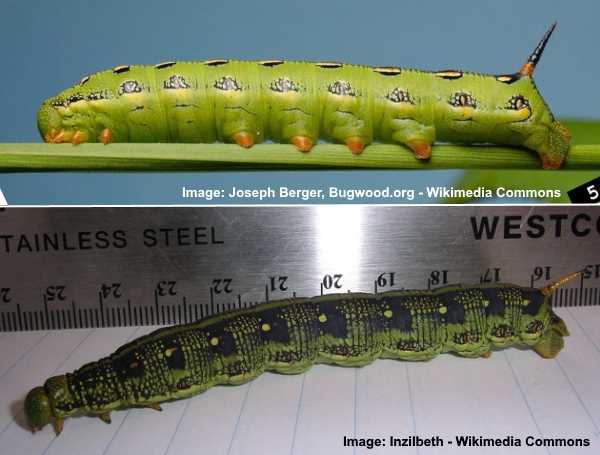
The white-lined sphinx caterpillar has many color variations, depending on its growth stage, and is common in Arizona
The white-lined sphinx moth caterpillar is a large lime-green or yellow-green caterpillar with black stripes and markings along its back and sides. In Arizona, this caterpillar looks like a long, plump worm-like insect. The black and pale-green larva has a small brownish head and a fleshy horn-like tail. This Arizona caterpillar measures 2.7” (70 mm) long.
White-lined sphinx caterpillars are common in Arizona after the monsoon season. In years with heavy rainfall, masses of these yellowish-green striped larvae are seen in large groups. They can become a pest in gardens, swimming pools, hiking trails, and roadways.
Although the striped caterpillar has a black-tipped orange or brown sharp-looking horn, this fleshy protrusion isn’t a stinger. The white-lined sphinx caterpillar is harmless to humans.
After pupation, the long green caterpillar turns into an attractive brown and pink moth.
- Adult Stage: Develops into the white-lined sphinx moth
- Caterpillar Feeds on: Various plants, including members of the nightshade family (Solanaceae)
- Habitat: Found in a variety of habitats, including deserts, gardens, and open fields. Commonly seen in North and South America
- Stinging: Does not sting
Two-Tailed Swallowtail Caterpillar (Papilio multicaudata)

The two-tailed swallowtail caterpillar turns from green to orangy-red before pupation
The two-tailed swallowtail caterpillar is the larva of Arizona’s state butterfly—the beautiful two-tailed swallowtail. The chubby caterpillar is identified by its humped back and conspicuous eyespots on its head. There are also bands of tiny dots traversing the caterpillar’s segments. The caterpillar has a slightly conical shape.
The two-tailed swallowtail caterpillar is green with pale white blotches, an enlarged head, and a yellow face when immature. During this stage, the green caterpillar looks somewhat like bird droppings. However, before pupation, the adult caterpillar is a reddish color with a black and white rim behind its enlarged head.
An identifying feature of this fat worm-like insect is its horn-like structure known as the osmeteria protruding from behind its head. This appears when the caterpillar feels threatened, and it also emits a foul stench.
- Adult Stage: Two-tailed swallowtail butterfly (Papilio multicaudata)
- Host Plants: Plants in the citrus family, including various species of citrus trees such as lemon, lime, and orange
- Habitat and Distribution: Found in western North America, particularly in the United States, including states like California, Nevada, and Arizona. They inhabit a variety of areas, including gardens, parks, and open woodlands
- Stinging: Does not possess stinging hairs or any other mechanism to cause skin irritation
Cabbage Looper (Trichoplusia ni)
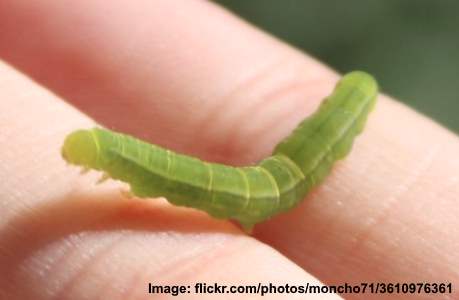
The green cabbage looper can cause a great damage to cabbage plants and is common in Arizona and other southern states
The cabbage looper is a harmless green caterpillar with a pale yellowish-green head and fine yellow bands separating its segments. The small green caterpillar has an identifiable crawling habit where it arches its back to form a looping motion. Sometimes the larva is entirely green; other times, it is paler with two broad white bands along its sides.
Before pupation, the green cabbage looper measures 1.2” to 1.5” (30 – 40 mm). These destructive green pests chew through cabbage leaves and can also bore into cabbage heads.
Apart from being common in Arizona, the cabbage looper is also a native caterpillar in Florida and other southern states.
- Adult Stage: Develops into a medium-sized moth
- Caterpillar Feeds on: Various crops and plants, including cabbage, lettuce, and beans
- Habitat: Found in agricultural fields and gardens. Common in North America and Eurasia
- Stinging: Does not sting
Cecropia Moth Caterpillar (Hyalophora cecropia)
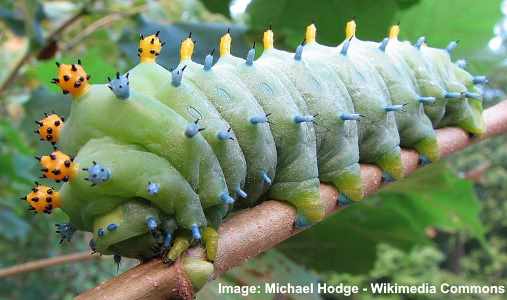
The Cecropia moth caterpillar is a large green caterpillar with yellow and blue nodules
The cecropia moth larva is one of the most unusual caterpillars in Arizona. The identifying features of this bluish-green caterpillar are orange, yellow, and blue ball-like spiked tubercles sitting on ridged segments. Each of these colorful bumps sprouts small black spikes. There are also bluish tubercles on its eight prolegs. The caterpillar’s head section is wider than its tail end.
The cecropia moth caterpillar reaches enormous lengths of 4” to 4.5” (100 to 110 mm). During its instars, this strange-looking Arizona caterpillar changes from a spiky black caterpillar to yellowish-green, then bluish green covered in colorful tubercles. .
- Adult Stage: Transforms into the cecropia moth
- Caterpillar Feeds on: Various deciduous trees and shrubs, including maple, birch, and cherry
- Habitat: Found in woodlands and forested areas where host plants grow. Common in parts of North America
- Stinging: Does not sting
Banded Woolly Bear Caterpillar (Pyrrharctia isabella)
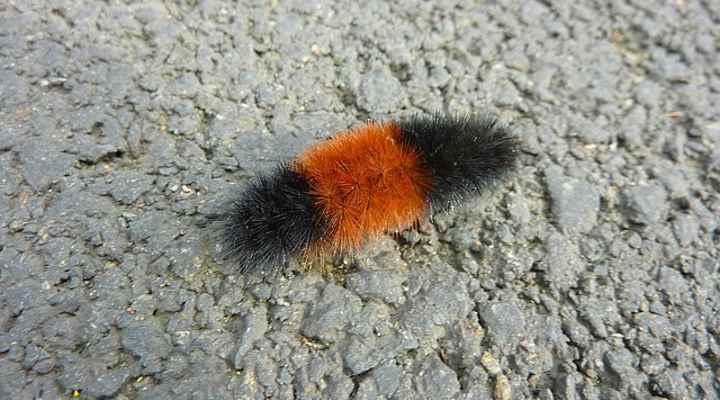
The banded woolly bear caterpillar is a furry caterpillar with black and orange or brown hairs
The banded woolly bear larva is an easily recognizable Arizona caterpillar due to its black fuzzy body with a brown-orange band around its middle. This black and orange furry caterpillar is not a stinging caterpillar, and its spiny covering doesn’t cause skin irritation. However, its sharp, spiny hairs can cause dermatitis in some people.
The black and brown hairy caterpillar is medium-sized, measuring around 2” (50 mm) long just before pupation. Apart from its bronze-colored band, an identifying feature of the woolly bear is how it rolls into a ball when threatened.
- Adult Stage: The adult form of this caterpillar is the Isabella tiger moth
- Host Plants: Woolly bear caterpillars are known to feed on a variety of plants such as aster, clover, birch, maple, elm, sunflower, and corn
- Habitat and Distribution: They can be found in open fields, gardens, and meadows across North America, particularly in the United States and southern Canada
- Stinging: Handling one of these fuzzy worm-like creatures with their spiky tufts of hair may cause skin irritation or contact dermatitis
Common Buckeye Caterpillar (Junonia coenia)
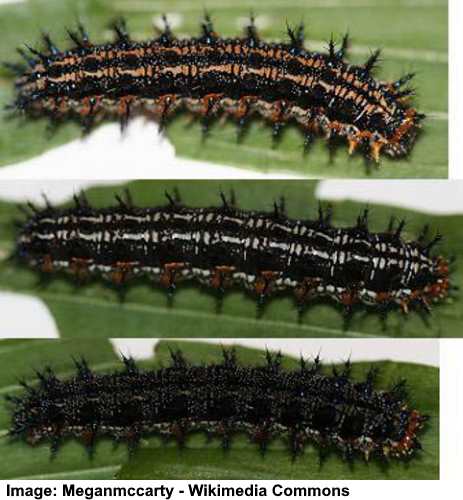
The common buckeye caterpillar has several color variations
The common buckeye caterpillar is a black, spiny caterpillar with orange markings, and an orange head. However, the species has several color variations. Some spiky black caterpillars have white stripes and brown markings, and others are without stripes but are covered in tiny white speckles.
The spiky black caterpillars measure 1.5” (40 mm) long with black spiny, fleshy tufts along their cylindrical bodies. You can find these long slug-like spiny larvae feeding on plantain, foxglove, and petunias.
- Adult Stage: The adult stage is commonly known as the buckeye butterfly
- Host Plants: Its caterpillars feed on various plants, including those from the snapdragon family (Scrophulariaceae) and plants from the Acanthaceae family
- Habitat and Distribution: The Junonia coenia caterpillar can be found in open areas, gardens, roadsides, and meadows throughout North and South America
- Stinging: There are no reported instances of the Junonia coenia caterpillar causing skin irritation or stinging
Monarch Caterpillar (Danaus plexippus)

The monarch caterpillar has yellow, white, and black stripes
The monarch butterfly larva is a striking striped caterpillar with black, white, and yellow bands around its abdomen. The large black and white caterpillar also has fleshy horns at either end of its stripy abdomen. The harmless monarch caterpillar in Arizona grows up to 1.7” (45 mm) long.
Apart from its stripy appearance, this Arizona caterpillar has two pairs of black fleshy horns—two long ones at one end and two shorter ones at the other end.
Due to its diet, the monarch caterpillar is poisonous to birds and predators. The large, plump cylindrical insect feeds on milkweed plants which create toxins in the caterpillar’s body—a deterrent making it taste nasty to other insects and birds.
- Adult Stage: Monarch butterfly
- Host Plants: Mainly feeds on milkweed plants, including common milkweed, swamp milkweed, and others in the Asclepias genus
- Habitat and Distribution: Found in various habitats including fields, meadows, and gardens, primarily across North America, but also found in some parts of South America, Western Europe, and Australia
- Stinging: Monarch caterpillars do not sting or cause skin irritation
Viceroy Caterpillar (Limenitis archippus)
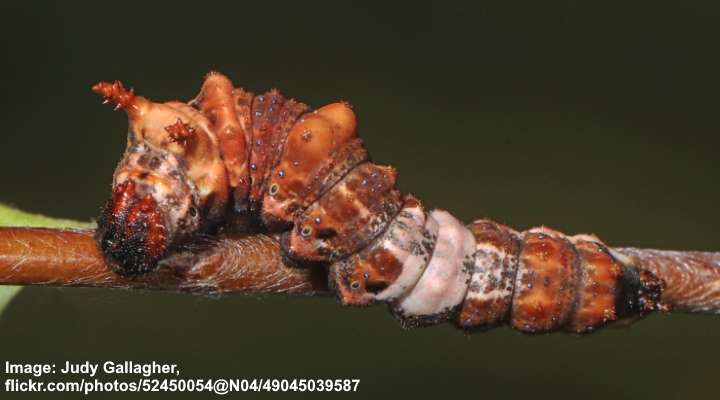
The viceroy caterpillar has brown, orange and white body with spiky horns at its head
The viceroy butterfly larva is a strange-looking brown caterpillar with mottled white patterns. This caterpillar’s abdomen has distinctive bumps, spiked protrusions, and dotted markings. In some instars, the viceroy caterpillar looks like bird droppings. The orange-brown and white spiny humped ugly viceroy caterpillar measures 0.6” (15 mm) long.
Viceroy caterpillars are often found on willow and cottonwood trees.
- Adult Stage: Viceroy butterfly, an orange and black butterfly
- Caterpillar Feeds on: Willow, poplar, and birch trees
- Habitat: Woodlands and gardens where host trees grow; primarily found in North America
- Stinging: No, they do not have stinging hairs
Variegated Fritillary Caterpillar (Euptoieta Claudia)
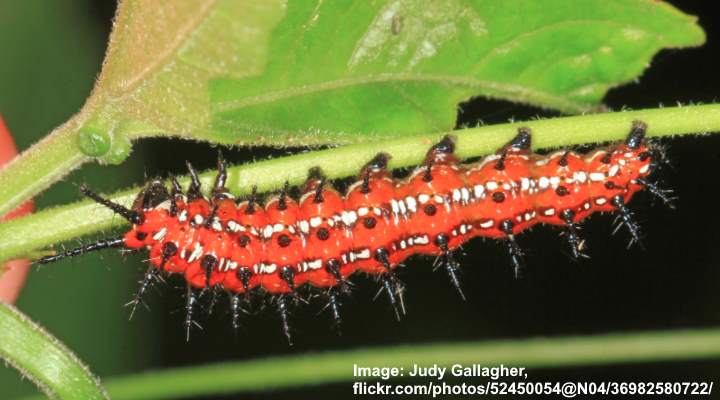
The large variegated fritillary caterpillar is identified by its orange-red spiked body with black and white lines
The larva of the variegated fritillary butterfly is an eye-catching orange or red Arizona caterpillar with numerous branched black spikes with longitudinal white and black stripes along its tubular body. The orange caterpillar also has identifiable rows of oval, bright white dots, brown-black legs and prolegs, and a pair of clubbed spines on its thorax.
The large orange and black variegated fritillary caterpillar is a tube-like insect measuring 3.5” (90 mm) long.
- Adult Stage: Variegated fritillary butterfly (Euptoieta claudia)
- Host Plants: Various species of violets (Viola) serve as primary food sources for the Variegated Fritillary caterpillar
- Habitat and Distribution: Found across much of North America, including regions such as the United States, Mexico, and parts of Canada. They inhabit open areas, including fields, meadows, and gardens
- Stinging: The variegated fritillary caterpillar does not possess stinging hairs or any other mechanism to cause skin irritation
Tobacco Hornworm (Manduca sexta)

The tobacco hornworm caterpillar is a large green caterpillar with white diagonal stripes
Also called the goliath worm, the tobacco hornworm caterpillar is a huge green insect with white diagonal stripes and black dots along its sides. This type of horned caterpillar also has a distinctive curled head and a rosy-pink curved horn-like tail. Also called the Carolina sphinx moth, the large caterpillar grows 2.7” (70 mm) in length.
The tomato hornworm (Manduca quinquemaculata) looks like the related tobacco hornworm caterpillar. The difference between the tobacco hornworm and the tomato hornworm is their markings and size. The tomato hornworm is 4” (100 mm) long and has V-shaped markings, not diagonal ones.

The tomato hornworm caterpillar has white V-shaped markings
- Adult Stage: Becomes the Carolina sphinx moth
- Caterpillar Feeds on: Tobacco, tomato, and other plants in the nightshade family (Solanaceae)
- Habitat: Found in gardens and agricultural fields. Common in North America
- Stinging: Does not sting
Giant Swallowtail Caterpillar (Papilio cresphontes)
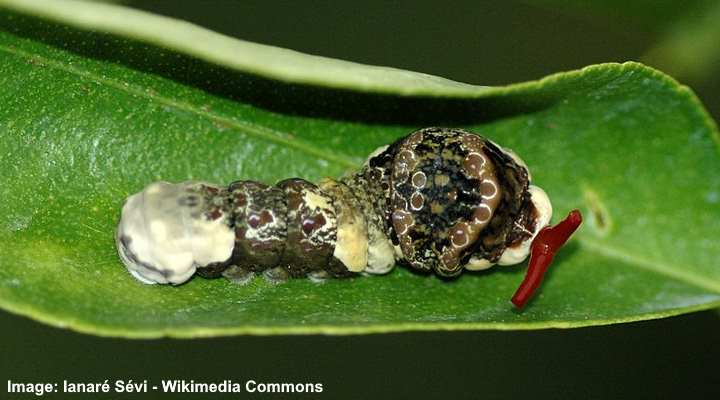
The giant swallowtail caterpillar looks like bird droppings. The pictures shows its red osmeteria, a structure that appears when the caterpillar feels threatened
The giant swallowtail is the larva of the largest butterfly in Arizona and North America. The ugly brown caterpillar has mottled white, black, and brown patterns, making the larva look like bird droppings. This camouflage defense mechanism makes the caterpillar hard to spot on tree and shrub branches.
Also called orange puppy or orange dog, the brown caterpillar has enlarged head and measures 2” (50 mm) long.
- Adult Stage: Giant swallowtail butterfly
- Host Plants: Citrus trees (Citrus species), including lemon, lime, and orange trees, as well as other plants from the Rutaceae family
- Habitat and Distribution: These caterpillars can be found in various habitats such as gardens, open areas, and forests, primarily in North America, including regions of the United States and southern Canada
- Stinging: The giant swallowtail caterpillar is not known to sting or cause skin irritation
Polyphemus Moth Caterpillar (Antheraea polyphemus)

the plump green polyphemus moth caterpillar has red dots with fine spikes along its body
The polyphemus moth caterpillar is a bright green silkworm with delicate spines emerging from red dots along its cigar-shaped body. This fat green, stumpy caterpillar is a small green spiky caterpillar when immature. It becomes engorged and plump as it feeds on birch, willow, hickory, and elm leaves.
The polyphemus caterpillar grows 3” to 4” (75 – 100 mm) long and is easily recognizable due to its neon-red spots.
- Adult Stage: Transforms into the polyphemus moth
- Caterpillar Feeds on: Leaves of various deciduous trees, including oak and maple
- Habitat: Found in woodlands and gardens where host trees grow. Commonly found in parts of North America
- Stinging: Does not sting
Red Admiral Butterfly Caterpillar (Vanessa atalanta)
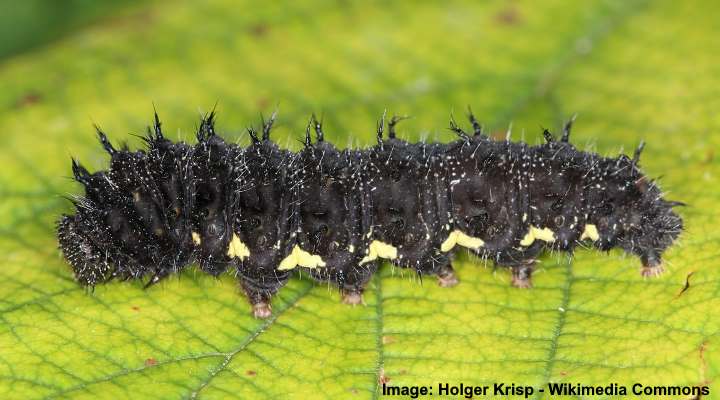
The red admiral caterpillar has black spiky body with tiny white dots
The red admiral caterpillar is a distinctive black caterpillar covered with fleshy black branched spines and tiny white dots. The spiky black caterpillar is slender during most instars. Before pupation, the caterpillar grows 1” (25 mm) long and becomes dark brown with thin black jagged spines.
There can be some color variation between red admiral caterpillars. Some varieties are pale brown with a line of creamy-yellowish dots along their sides. In contrast, others are shiny black with black spiny spikes and a broken white stripe along their abdomens.
- Adult Stage: The red admiral caterpillar develops into the red admiral butterfly, which is recognized by its distinctive black wings with red-orange bands
- Host Plants: These caterpillars primarily feed on plants from the nettle family
- Habitat and Distribution: Red admiral caterpillars are found in various habitats, including gardens, meadows, and woodlands, and are widely distributed across North America and Europe
- Stinging: The red admiral caterpillar is not known to sting or cause skin irritation
Silver-Spotted Skipper Caterpillar (Epargyreus clarus)
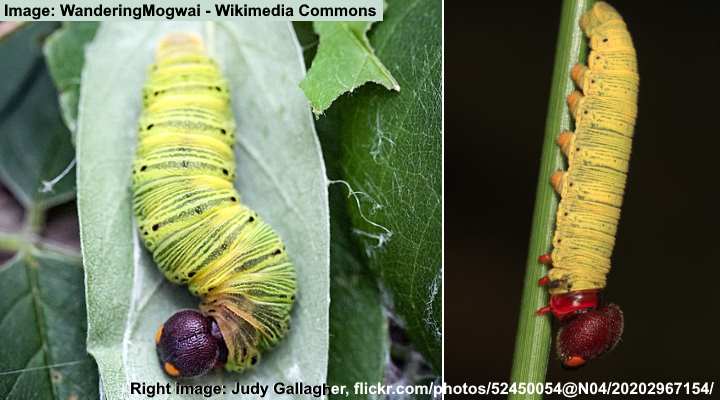
The silver-spotted skipper caterpillar has yellow body with fine green stripes and brown-reddish head
The silver-spotted skipper caterpillar is a yellow caterpillar with thin green bands around its plump segments and a conspicuous ball-like reddish brown head with two large orange spots. The striped, yellow caterpillar has identifying characteristics like bright orange eye spots, bright red throat, and red feet. The yellowish-green caterpillar measures 2” (50 mm) long.
- Adult Stage: Transforms into the silver-spotted skipper butterfly
- Caterpillar Feeds on: Leaves of leguminous plants, including beans and peas
- Habitat: Found in open areas, gardens, and fields. Common and widely distributed in North America
- Stinging: Does not sting
Spotted Tussock Moth Caterpillar (Lophocampa maculata)
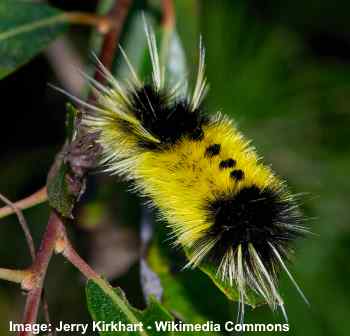
The yellow-spotted tussock caterpillar has a distinctive look with its yellow and black hairs
The easily identifiable spotted tussock moth caterpillar is a hairy yellow and black caterpillar with prominent white tufts of long pencil hairs sticking out from either end, and a row of black dots on its yellow band. The small fuzzy, yellow-banded caterpillar also has the common name yellow woolly bear. This yellow and black insect grows 1.1” (30 m) long.
You will find the black-spotted yellow tussock caterpillar feeding on poplar, willow, birch, oak, and maple trees.
- Adult Stage: Yellow spotted tussock moth
- Host Plants: Feeds on a variety of plants, including oak, willow, maple, and various other deciduous trees and shrubs
- Habitat and Distribution: Found in diverse habitats such as forests, woodlands, and urban areas, primarily in North America
- Stinging: The yellow spotted tussock moth caterpillar can cause skin irritation upon direct contact due to the presence of irritating hairs
Crowned Slug Moth Caterpillar (Isa textula)

The unusual-looking crowned slug caterpillar has stinging spines along its sides
The crowned slug caterpillar is a strange-looking Arizona caterpillar with a flattened oval body covered in stinging spines. Apart from the venomous yellow spines, the green stinging caterpillar has red or yellowish margins and two raised yellow lines on its back.
The tiny oval stinging caterpillar looks like a leaf that grows 0.6” (15 mm) long. It’s best to stay clear of this spine-covered green caterpillar because it can give you a nasty sting.
- Adult Stage: Develops into the crowned slug moth
- Caterpillar Feeds on: Various deciduous trees and shrubs
- Habitat: Found in woodlands and gardens. Found in North America from Minnesota, southern Ontario and Massachusetts to Florida, Texas, and Mississippi
- Stinging: Does not sting
Western Tent Caterpillar (Malacosoma californicum)
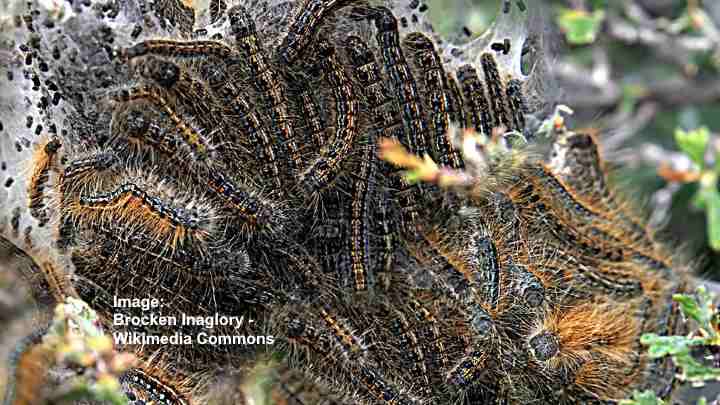
The hairy Western tent caterpillar has a long black and orange body
The western tent caterpillar is a slender worm-like furry black larva covered in orange or dark yellow tufts of fine setae (hairs). The orange and black caterpillar gets its name from the tent-like web structures where hundreds of the leaf-destroying bugs live. The furry caterpillars can grow up to 2.5” (50 mm) long.
- Adult Stage: Western tent moth
- Host Plants: Various trees including cottonwoods, willows, and fruit trees
- Habitat and Distribution: Native to western North America, commonly found in forests, woodlands, and riparian areas
- Stinging: No significant reports of stinging or causing skin irritation in humans
Black Swallowtail (Papilio polyxenes)
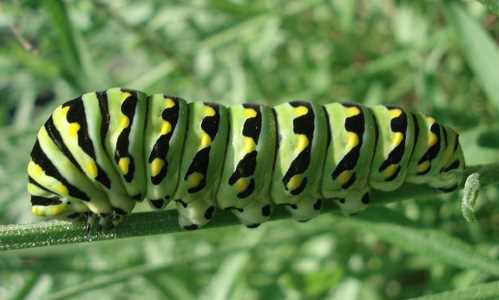
The black swallowtail caterpillar is identified by its black stripes and yellow markings on its green body
The black swallowtail larva tail is a large, engorged bright green caterpillar with bands of yellow and black markings. The striped, green larva has identifiable black bands with yellow spots around each segment. Just before pupation, this stripy green caterpillar grows around 1.5” (40 mm). However, the immature black swallowtail caterpillars are black and white.
The black swallowtail caterpillar in Arizona is a poisonous type of crawling insect. Although it’s harmless to humans, the larva develops toxins that make it toxic to birds and predators.
- Adult Stage: Transforms into the black swallowtail butterfly
- Caterpillar Feeds on: Various plants from the carrot family (Apiaceae), including parsley, dill, and fennel
- Habitat: Found in gardens, meadows, and fields where host plants are present. Common and widespread across North America
- Stinging: Does not sting
Southern Flannel Moth Caterpillar (Megalopyge opercularis)
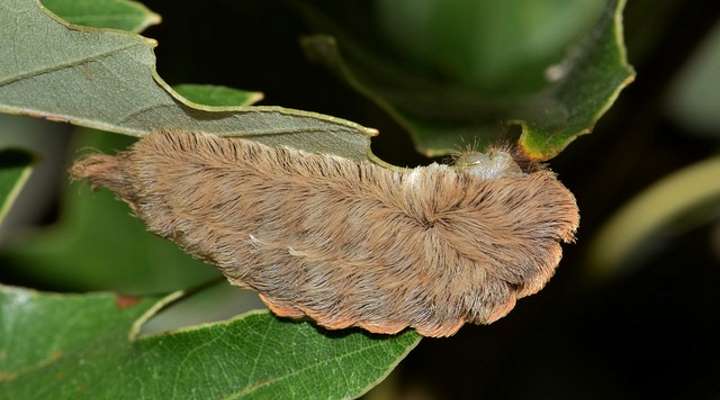
The furry Southern flannel caterpillar has light brown hairs and is commonly found in Arizona
The southern flannel moth larva is a type of hairy stinging caterpillar found throughout Arizona with teardrop-shaped body. The golden brown venomous caterpillar has a deceptive soft appearance. Despite being covered in luxuriant hairs, the fluffy hairs hide the stinging spines on this tiny furry caterpillar. This stinging caterpillar grows between 1” and 1.5” (25 – 38 mm).
The southern flannel moth caterpillar adapts well to hot, dry environments—which is why the caterpillar is commonly found in Texas and Arizona. Other names for the unusual stinging insect are Fire caterpillar, puss moth, tree asp, and woolly slug.
- Adult Stage: Southern flannel moth
- Host Plants: Feeds on various trees and shrubs, including oak, elm, and sycamore
- Habitat and Distribution: Found in diverse habitats such as forests, gardens, and urban areas, primarily in the southern United States, Mexico, and parts of Central America.
- Stinging: The puss caterpillar possesses venomous spines that can cause severe pain and skin irritation if touched
Yellownecked Caterpillar (Datana ministra)
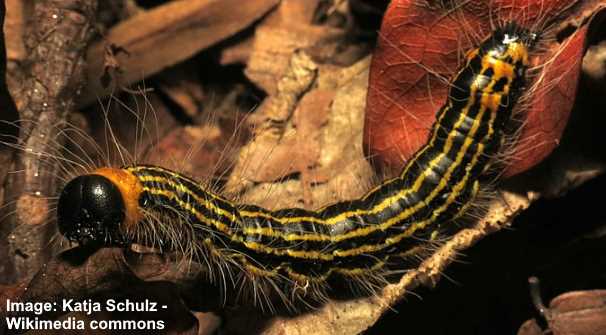
The yellownecked caterpillar has black and yellow bands along its hairy body
The yellownecked moth larva is a black and yellow striped caterpillar with an orange throat and bulbous black head. A feature of the stripy Arizona caterpillar is wispy spines giving it a fuzzy appearance. This yellow and black hairy caterpillar has a cylindrical body that measures 1” (50 mm) long.
- Adult Stage: Transforms into the yellownecked caterpillar moth
- Caterpillar Feeds on: Consumes the leaves of deciduous trees, including hickory and walnut
- Habitat: Common in North America, often in forests and woodlands
- Stinging: Yellownecked caterpillar larvae may have mildly irritating spines but are not known for severe stings
Arizona Caterpillars – FAQ
What are the little black and yellow caterpillars in Arizona?
Little black and yellow caterpillars found in Arizona could potentially be the larvae of the white-lined sphinx moth (Hyles lineata). These caterpillars are commonly observed in the southwestern United States, including Arizona. They are characterized by their black and yellow coloration and can often be found feeding on various plants, including members of the family Solanaceae, such as tomatoes, peppers, and potatoes.
What caterpillars sting in Arizona?
Two types of stinging caterpillars found in Arizona are the Southern Flannel Moth Caterpillar, known as the puss caterpillar, and the Crowned Slug Moth Caterpillar. Contact with their venomous spines can cause significant pain and irritation, making it important to avoid handling them.
What is the huge green caterpillar in Arizona?
In Arizona, the large green caterpillar you might come across is likely the larva of the White-lined Sphinx Moth (Hyles lineata). These caterpillars are known for their significant size, often reaching lengths of several inches. They have robust green bodies with a horn-like projection at the rear end. These caterpillars can frequently be found feeding on various plants, including members of the nightshade family such as tomatoes, peppers, and other garden plants.
Related articles:
